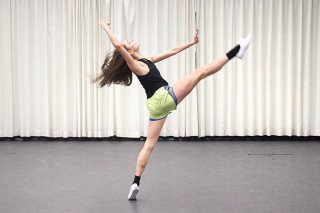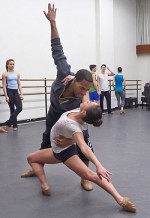Title

Hope Dougherty in rehearsal for Eliot Feld's The Jig Is Up, part of this year's Juilliard Dances Repertory program.
(Photo by Jeffrey Cuyubamba) More Photos »Created within a six-year span (1979-85) when New York’s dance scene was especially vibrant and invigorating, the three works on the 2014 Juilliard Dances Repertory program (March 21-25) represent that thriving era’s bountiful creativity. They also represent three major choreographers working at their peak, each of whom combines an individual musical sensibility with mature craftsmanship and distinctively idiosyncratic flair.
Body
All three choreographers—Eliot Feld, Lar Lubovitch (’64, dance), and Twyla Tharp—first presented their work during the mid-to-late-1960s, and all remain quite active today. At the time they made these dances, each had longstanding companies of loyal dancers whose skills and personalities they challenged and showcased. The three dances that will be presented at Juilliard—Feld’s The Jig Is Up, Lubovitch’s Concerto Six Twenty-Two, and Tharp’s Baker’s Dozen—became signature works of their respective companies as well as repertory mainstays.
For the Juilliard students who will perform the works this spring, this program offer an opportunity to encounter and assimilate the dances through intensive work with two of the choreographers—Feld and Lubovitch—and, for the Tharp, a member of the original cast, Shelley Washington (’74, dance). The goal for everyone involved has been not only to communicate and embody each work’s original intentions, but to allow these dancers of 2014 to make them very much their own.
Since the final week in January, the third-floor studios have hummed with intensive activity—and three very different kinds of music—as these dances took shape. With each to be performed by two alternating casts, more than 70 people were rehearsing five afternoons a week.
In one studio, Feld, assisted by his former company member and longtime associate Patrice Hemsworth, prepared The Jig Is Up (1984), which captures the robust vigor and infectious rhythms of Irish folk music by the Bothy Band and others. Meanwhile, Mozart’s Clarinet Concerto, K. 622 (hence the name of the dance), was playing in the studio where Lubovitch and several assistants were bringing his Concerto Six Twenty-Two, first seen in 1985, to life. In another, the rhythmic intricacies and infectious melodies of Willie “The Lion” Smith’s jazz piano compositions set the tone for 24 dancers working with Washington on Tharp’s Baker’s Dozen (1979).
Feld has been a familiar face around Juilliard over the past decade, staging Skara Brae for the 2011 Juilliard Dances Repertory, and in 2005 creating the inventive Sir Isaac’s Apples for all four Dance Division classes. The Jig Is Up, in eight sections, ranges from playful to romantic to earthy. Hemsworth, who danced with Feld’s company in the late 1980s, told The Journal, “We danced Jig every year; it was very popular at the time. It’s exhilarating, free, flowing—a wonderful piece to dance. It’s about community, so there’s a great message about connecting.”
“These dancers are terrific—they’re so smart and beautiful,” Hemsworth added. “They’ve worked with so many different choreographers, so they’re versatile and quick. They really commit themselves wholeheartedly to what they’re working on. The easy part is getting them to do the steps. The most challenging part is the nuance of the piece: the particular phrasing, the lightness of attitude about it.”
Early in the second week of Concerto Six Twenty-Two rehearsals, Lubovitch was observing and refining the first movement, in which fluent ensemble circling patterns open up for duets that ride along the score’s buoyant rhythms. He and an assistant demonstrated the transitions that connect the solos, helping the dancers find their way into the work’s seamless structure.
This dance, which The New York Times called “a stunningly inventive piece of choreography” when it premiered, in 1985, has become one of Lubovitch’s most celebrated works, known particularly for its eloquent central male duet. “When this was created, it had a specific connotation. It was the height of the AIDS crisis,” the choreographer told The Journal just before the rehearsal. “The piece had an emerging theme of friendship—in a very deep way. Friends were helping friends die, so it was really a demonstration of friendship. The central movement really assays that in depth, but the outer movements are also about that spirit.”
But Lubovitch doesn’t consider that background essential information for the Juilliard dancers, for whom the mid-1980s are, of course, a moment in history. “I don’t think it’s necessary for them to know that. It’s about doing the steps to the music with the right dynamic and the right spirit, embodying what’s required of them as dancers,” he said. And though just one week had passed, he said he was impressed by the dancers’ talent and the speed with which they learned the material. “That’s something that’s changed over the decades—learning quickly,” he added. Being a quick study “didn’t used to be a requirement,” he noted. “It’s a very modern notion of what it means to be a dancer.”
That ability to learn quickly was also being put to the test in the Baker’s Dozen studio. One of Tharp’s finest works, it radiates warmth and good humor, but its look of casual ease is deceptive. Even after dancing the work for years and staging it several times, Washington still marvels at the intricacy of its craftsmanship. “This ballet is a diamond. It’s such perfection,” she told The Journal during the first week of rehearsals. “The craftsmanship is brilliant.” Washington danced in the company of former faculty member Martha Graham after Juilliard before joining Tharp, with whom she danced for 15 years; she has been staging Tharp’s work since 1990. “Every time you stage Baker’s Dozen, you learn a little bit more,” she said. “It’s like the perfect meal, when you get up and you’re not overstuffed and you’re not starving.”
Tharp created Baker’s Dozen in the aftermath of the 1979 film version of Hair, for which she did the choreography, when she returned to the essence of her creative process after the collaboration required in film. In her autobiography, Tharp wrote, “Baker’s Dozen was made to extol economy after the flamboyant wastefulness of Hollywood. All the same, it gives just that little bit extra, the baker’s generous measure of 13.” Tharp had made videotapes of herself dancing during her pregnancy eight years earlier—improvising to the jaunty, insouciant melodies of Willie “The Lion” Smith—and was inspired to make the dance after revisiting those tapes.
“Twyla Tharp always knows the music backward and forward and inside out, before we ever even start on a dance,” Washington said. “For Baker’s Dozen, I remember her coming in with the score and everything noted in it—who comes in where. She created the opening series of duets with the women entering in order of company seniority. It was a great time. The company came back after Hair. All of a sudden, she was charged with all this new energy. She had 12 dancers for the first time.”
Each of the four sections of Baker’s Dozen is full of wit and playfulness. Tharp masterfully arranges and rearranges her dozen dancers—trios, quartets, sextets—as well as a deft finale in which they emerge from the ensemble for brief jewel-like solos. As Washington notes, “This piece is so fast! It’s jam-packed.” As she guided the Juilliard dancers through its intricacies, Washington emphasized the importance of listening to the score. “We burned CDs of the music for all the dancers. I said, ‘take it and listen to it all the time.’”
Washington said that she started by telling the dancers “I want it to be about you,” and that she didn’t want to be saying “I did it this way.” As she passes Baker’s Dozen on to the Juilliard dancers, she hopes they will “discover new things about themselves in the way we discovered new things about ourselves when we were in 1979.”








